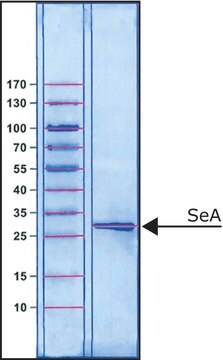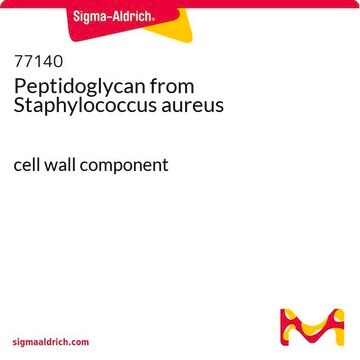H9395
α-Hemolysin from Staphylococcus aureus
lyophilized powder, Protein ~60 % by Lowry, ≥10,000 units/mg protein
Synonym(s):
α-Toxin
About This Item
Recommended Products
biological source
Staphylococcus aureus
Quality Level
form
lyophilized powder
specific activity
≥10,000 units/mg protein
contains
sodium citrate buffer as balance
composition
Protein, ~60% Lowry
solubility
H2O: soluble 0.49-0.51 mg/mL
UniProt accession no.
storage temp.
2-8°C
Gene Information
Staphylococcus aureus ... SAOUHSC_01121(3920722)
General description
Application
- as a component of electrolyte solution for testing pore formation in lipid bilayer using electrophysiological measurements
- to test its osteogenesis suppressive effects in bone marrow stromal cells (BMSCs)
- in the preparation of α-hemolysin molecular imprinted polymer (MIP) for Biacore and surface plasmon resonance
Biochem/physiol Actions
Packaging
Unit Definition
Signal Word
Warning
Hazard Statements
Precautionary Statements
Hazard Classifications
Eye Irrit. 2 - Skin Irrit. 2 - STOT SE 2
Target Organs
Lungs,Blood
Storage Class Code
11 - Combustible Solids
WGK
WGK 3
Flash Point(F)
Not applicable
Flash Point(C)
Not applicable
Personal Protective Equipment
Certificates of Analysis (COA)
Search for Certificates of Analysis (COA) by entering the products Lot/Batch Number. Lot and Batch Numbers can be found on a product’s label following the words ‘Lot’ or ‘Batch’.
Already Own This Product?
Find documentation for the products that you have recently purchased in the Document Library.
Customers Also Viewed
Related Content
Cell lysis and protein extraction methods overview various techniques, from detergent solubilization to mechanical disruption, supporting research needs.
Our team of scientists has experience in all areas of research including Life Science, Material Science, Chemical Synthesis, Chromatography, Analytical and many others.
Contact Technical Service
















